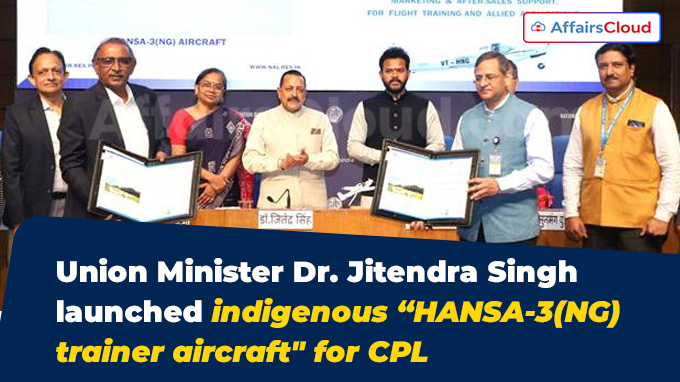 On 4 April 2025, Union Minister of State (MoS) (Independent Charge (IC)), Dr. Jitendra Singh, Ministry for Science & Technology (MoS&T), launched indigenous ‘HANSA-3(Next Generation,NG)’ aircraft at the National Media Centre (NMC) in New Delhi (Delhi). He also announced the plan to involve the private sector to collaborate in the manufacture of this aircraft.
On 4 April 2025, Union Minister of State (MoS) (Independent Charge (IC)), Dr. Jitendra Singh, Ministry for Science & Technology (MoS&T), launched indigenous ‘HANSA-3(Next Generation,NG)’ aircraft at the National Media Centre (NMC) in New Delhi (Delhi). He also announced the plan to involve the private sector to collaborate in the manufacture of this aircraft.
- A two-seater trainer aircraft is indigenously designed and developed by Bengaluru(Karnataka) based Council of Scientific & Industrial Research – National Aerospace Laboratories (CSIR-NAL).
- This marks the 1st time aircraft will be manufactured in India using fully indigenous design and technology.
Key Points:
i.During the event, the CSIR-NAL has r formalized the Transfer of Technology (ToT) agreement with Mumbai(Maharashtra)-based P M/s Pioneer Clean Amps Private Limited for the manufacturing, commercialization, marketing, and after-sales support of the HANSA-3 (NG) aircraft.
ii.M/s Pioneer Clean Amps will initially manufacture 36 aircraft per year, scaling to 72 annually to meet the domestic and export demand.
iii.CSIR-NAL has received Letters of Intent (LOIs) for over 110 HANSA-3(NG) from Flying Training Organizations (FTOs) across India.
iv.It will fulfill the requirements of flying clubs in providing both Private Pilot License (PPL) and Commercial Pilot License (CPL) training to the young generation.
Note: Currently, all aircraft used in India’s flight training organizations are imported.
About HANSA-3(NG) Aircraft:
The HANSA-3(NG) is the latest version of the HANSA planes that NAL has been making since 1998.
- Currently, 14 Hansa planes are in use by the Ministry of Civil Aviation (MoCA) and various Indian Institutes of Technology (IITs).
Modern Features of HANSA-3(NG):
i.The HANSA-3(NG) offers an advanced digital display (glass cockpit) system using certified instruments.
ii.It is powered by an advanced fuel-injected Rotax 912 iSc3 Sports engine, having best-in-class efficiency along with a lightweight 2-bladed composite propeller.
iii.With a cabin width of 43 inches, HANSA-3(NG) offers comfortable seating with comfortably designed seats to fit tall as well as shorter pilots/occupants equally well.
iv.The low wing and bubble canopy, along with the rear windows, offer an excellent view of the surroundings to the pilot for comfortable flight.
v.It features electrically operated flaps, and it offers excellent performance with a range of 620 nautical miles (nm), 7 hours of endurance, and a maximum cruise speed of 98 Knots Calibrated Airspeed (KCAS).
Future Pilot Demand in India:
i.India will need 30,000 pilots over the next 15–20 years, up from the current 6,000–7,000 pilots, as Indian airlines collectively have over 1,700 aircraft on order.
ii.Currently, India’s commercial aircraft fleet stands at over 800 aircraft.
- Typically, each aircraft requires 15–20 pilots for narrow-body aircraft and 25–30 pilots for long-range, wide-body jets.
About the Council of Scientific & Industrial Research – National Aerospace Laboratories (CSIR-NAL):
The CSIR-NAL is the only government aerospace Research and Development (R&D) laboratory in India’s civilian sector.
Director– Dr. Abhay Anant Pashilkar
Headquarters– Bengaluru, Karnataka
Established– 1959




